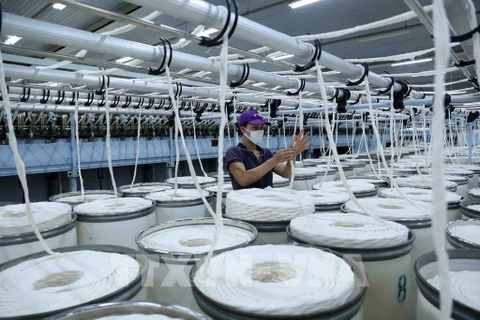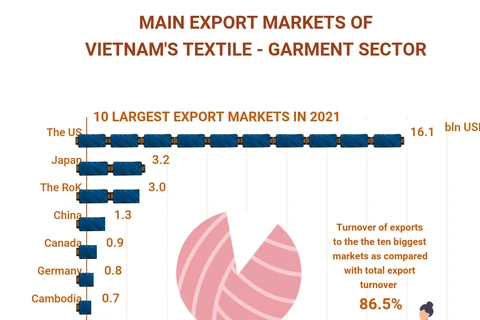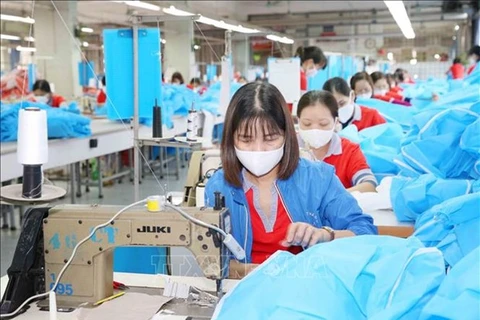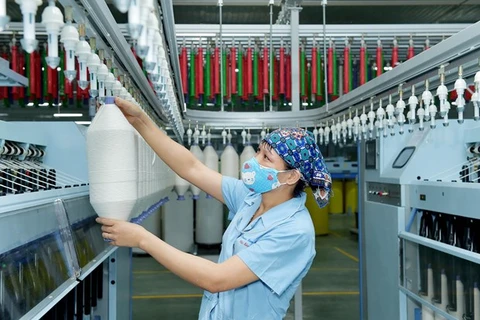Hanoi (VNA) – By the end of the first quarter of 2022, garments and textiles continued to rank in the group of products earning billions of USD from exports as they contributed 8.84 billion USD to the country’s total turnover, up 22.5% from the same period last year.
Despite direct impacts from the COVID-19 pandemic, the garment-textile industry has firmly overcome a wide range of difficulties and continued to reap promising export results in the first three months of 2022.
Flexible adaptation
The garment-textile industry is one of the most labour intensive sectors in Vietnam. Therefore, when workers contract COVID-19, it will directly affect production and business activities of enterprises.
Tran Tuong Anh, Deputy General Director of Hoa Tho Textile – Garment Joint Stock Corporation, said by beginning of March 2022, the company’s total number of employees contracting COVID-19 (F0) and close contacts (F1) had reached 1,719, accounting for 15% of its workforce.
Because a large number of workers have been on sick leave, the company has faced an array of difficulties in making production plans. In addition, when workers returned to work after they got over the disease, their health remained weak, resulting in lower productivity.
Hence, the corporation had to negotiate with its partners to re-adjust delivery times, rearrange production plans and prioritise production urgent orders.
“Employees who previously worked indirectly were mobilised to directly take part in production. Besides, our company have also built plans and arranged a separate dining room and working area for F0s when the administration and the health sector permit,” Anh said.
Garment 10 Corporation – Joint Stock Company was in the same plight as the Hoa Tho Textile – Garment Joint Stock Corporation. Since the Garment 10 Corporation – Joint Stock Company has many factories nationwide, the rates of F0 ranged from 10% to 40% in provinces and cities.
“Our company had to dispatch workers from units with fewer F0s to others which have many F0s but still maintain production activities,” said Bach Thang Long, Deputy General Director of the Garment 10 Corporation – Joint Stock Company.
Maintaining growth pace
Over the past two years, especially during the peak period of the fourth wave of COVID-19 infections, garment enterprises faced difficulties when the material and accessory supply chains were disrupted, even some factories had to shut down.
Hoang Van Linh, Chairman of Aligro Joint Stock Company, said garments are seasonal products, adding that winter clothes are produced since the beginning of summer.
Therefore, Aligro prioritised orders having enough materials and accessories. In addition, the company has clear process and regulations so it has managed to ensure stable inputs and jobs for workers with stable incomes.
“Amid complicated developments of the COVID-19 pandemic, Aligro paid due attention to stabilising the spirit and resources in order to promptly respond and avoid losses. Leaders and employees of the company must have responsibility for themselves and the community,” Linh said.
Companies have focused more on social security, thus helping their employees feel secure with their jobs and businesses.
A representative of the Hoa Tho Textile – Garment Joint Stock Corporation said, when its employees contracted COVID-19 and were on sick leave for treatment in line with regulations of the Ministry of Health, they were fully entitled to illness regimes. When these employees were back to work, they were subsidized 300,000 VND a day and free meals during their work shifts in two weeks.
In addition, the Hoa Tho Textile – Garment Joint Stock Corporation regularly disseminated information to employees to improve awareness on COVID-19, and actively take measures to improve their health.
For those who had to quarantine themselves, the company maintained social insurance payments and offered 50,000 VND per person a day and provided them with rapid test kits. For F1s who still went to work as usual, worked in a separate area to prevent COVID-19 infections.
Vietnam has changed its policy from zero COVID-19 to safely and flexibly adapting to and effectively controlling the pandemic, while boosting socio-economic recovery and development in line with the government’s Resolution 128/NQ-CP.
Statistics released by the Ministry of Industry and Trade, garment-textile exports raked in 8.84 billion USD in the first quarter of 2022, up 22.5% year on year.
This was an important premise for the garment-textile industry to achieve the set target of 43 billion USD in export turnover and increase its market share on the international market./.
























